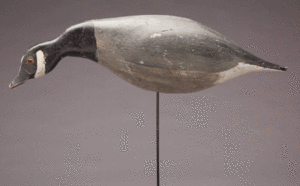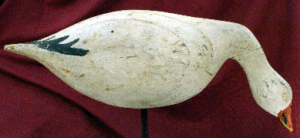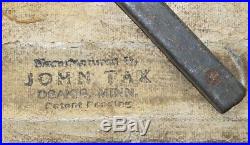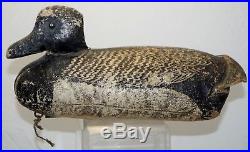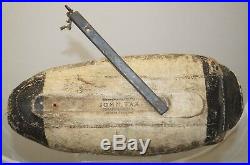A Decoy Corner Article
By Bruce Urben, President
I am switching up our Decoy Corner carver review again this month from Wisconsin to our nearby neighbor in the Gopher State – Minnesota. John Tax is one of the most well known Minnesota carvers and here is his story:
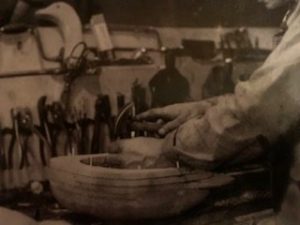 John Franklin Tax was born on September, 11, 1894, to his parents, Anton and Helene Tax. He was the oldest of four children. His parents lived their entire life in Osakis, Minnesota (West Central MN) where they owned and ran a leather harness shop. His mother died early in his life, followed by his father in 1905. John’s stepmother looked after the children and John began working in his dad’s harness shop at the age of 12. John was nurtured in nature and art by one of his father’s employees at the harness shop, Gene Erwin. Gene was an amateur artist and taught John how to whittle and make things out of wood.
John Franklin Tax was born on September, 11, 1894, to his parents, Anton and Helene Tax. He was the oldest of four children. His parents lived their entire life in Osakis, Minnesota (West Central MN) where they owned and ran a leather harness shop. His mother died early in his life, followed by his father in 1905. John’s stepmother looked after the children and John began working in his dad’s harness shop at the age of 12. John was nurtured in nature and art by one of his father’s employees at the harness shop, Gene Erwin. Gene was an amateur artist and taught John how to whittle and make things out of wood.
Shortly after his father’s death, John slowly began his carving career. First, carving decoys for his own use. John’s grandfather mentored him in hunting, fishing and trapping and became an avid waterfowler. After John’s stint in the navy during World War 1, he came back to Osakis and married Ada Olivier in 1922. Together they had four children of their own. During the 1920’s, John began carving more working decoys, and later began guiding duck hunters in Minnesota’s prairie region.
The decoys John carved were as varied as his hunting methods. They ranged from cork decoys, to stuffed canvas decoys, to laminated hollow body stickup decoys. His cork decoys were made with a wood bottom board and wood heads, his canvas covered decoys were stuffed with cedar shavings and lead weights for balance in the water. John actually patented his canvas decoy design in 1939! His laminated wood stick up decoys created the most interest among collectors. They were constructed of hollowed out pine planks, laminated together using pegs and glue – some with up to 11 layers of donut-like sections. His stick up decoys included Canada geese, snow geese, mallards and speckle belly geese. In addition to his “stick up” decoys, he carved wood rigs of bluebills, teal, coot and wood ducks, those species frequenting the prairies of Minnesota. All of John’s decoys portray a lifelike impression of the real bird. His painting was done with two coats of primer (white lead paint, turpentine and spar varnish), followed by a final paint of tinted lead paint, which was the outdoor paint of that time!
Experts claim that Tax may have only carved several hundred decoys in his lifetime; however there are only 85 known Tax decoys accounted for at this time. John Tax passed away in his home town of Osakis, MN on July 15, 1967. Osakis Minnesota honored John Tax by proclaiming June 8, 1996 as “John Tax Day”.
As you might expect, John Tax decoys are in high demand by collectors. Several have been documented as being sold at decoy auctions at bids of $20,000-$40,000. Many decoy collectors would be pleased to add a John Tax decoy to their collection, but unfortunately only a few will have that pleasure.
John Franklin Tax – The Gopher’s State famous Prairie Decoy Carver.

